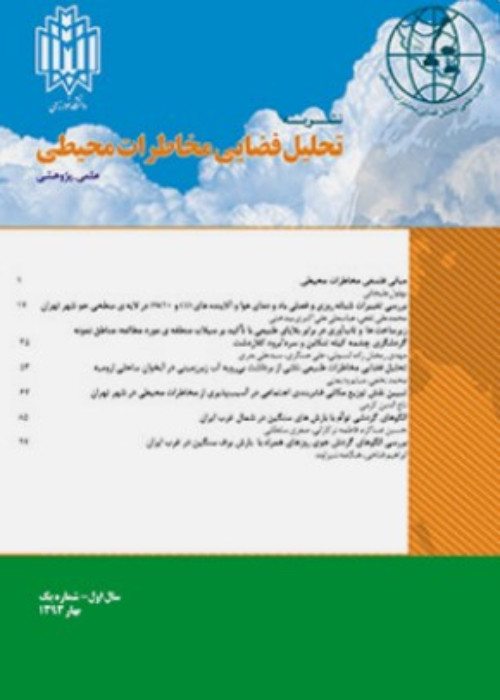Investigation of Temperature and Precipitation Changes in the Seymare Basin by Using CMIP5 Series Climate Models
Panel reports on climate change suggest that climate change around the world is most likely due to human factors. Temperature and precipitation are two important parameters in the climate of a region whose variations and fluctuations affect different areas such as agriculture, energy, tourism and so on. Seymareh basin is one of the most significant sub-basins of Karkheh. The purpose of this study is to predict the impact of climate change on precipitation and temperature of the Seymareh Basin in 2021-2040 period. These effects were analyzed at selected stations with uncertainties related to atmospheric general circulation models (GCMs) of CMIP5 models under two scenarios of RCP45 and RCP85 through LARS-WG statistical model. Then the uncertainties of the models and scenarios were investigated by comparing the monthly outputs of the models by the coefficients of determination coefficient (R2) in the forthcoming period (2021-2040) with the base period (1980–2010). The root mean square error (RMSE) calculations presented the best model and scenarios for generating future temperature and precipitation data.The Seymareh catchment is the largest and the main Karkheh sub-basin that covers parts of Kermanshah, Lorestan and Ilam provinces. The length of the largest river at the basin level to the site of the Seymareh Reservoir Dam is approximately 475 km, and the area of the basin is 26,700 km2. Geographic coordinates of the basin are from 33° 16 ́ 03 ̋to 34°59 ́ 29 ̋north latitudes and 46°6 ́9 ̋to ̋ 5 ́ 0 ° 49 Eastern longitudes, minimum basin height 698 m at the dam outlet and its maximum height 3,638 m. It is on the western highlands of Borujerd. The information used in this study was obtained from the Meteorological Organization of the country. For this study, three synoptic stations of Kermanshah, Hamadan and Khorramabad, which had the highest statistical records and had appropriate distribution at basin level, were used. These data included daily and monthly temperature and precipitation information, and sunshine hours. The LARS-WG fine-scale exponential model was proposed by Rasko et al., Semnoff and Barrow (1981). We used daily data at stations under current and future weather conditions. In order to select the best GCM model from the models mentioned above, minimum temperature, maximum temperature, precipitation and sunshine data were entered daily in the base period (1980–2010) and data were generated for five models under two scenarios of RCP45 and RCP85 for the period 2040–2021. The data were generated in 100 random series and the mean of required variables (minimum temperature, maximum temperature and rainfall) were extracted monthly in the period 2021-2040. Then, root mean square error (RMSE) and determination coefficient (R2) were used to evaluate the performance of the models and compare the results. To ensure the models' ability to generate data in the coming period, computational data from the model and observational data at the stations under study should have been compared. The capability of the LARS-WG model in modeling the minimum temperature, maximum temperature, and radiation at the stations under study was completely consistent with the observed data. The model's ability to exemplify rainfall was also acceptable, however the highest modeling error was related to March rainfall. By comparing the observed and produced data including monthly average precipitation, minimum and maximum temperatures through five mentioned models with their indices, the best model and scenario for future fabrication were determined. The results of this comparison showed that among the available models, HADGEM2-ES model under RCP 4.5 scenario had the best result for precipitation and HADGEM2-ES under RCP 8.5 scenario predicted the best result for maximum temperature. Determining the best model, precipitation data, minimum temperature and maximum temperature produced in the selected models and scenarios were analyzed to investigate the climate change temperature and precipitation for the future period. The results of this study indicated that due to the wide range of output variations of different models and scenarios, by not taking into account the uncertainties of the models and scenarios can have a great impact on the results of the studies. It was also found in this study that the LARS-WG exponential model was capable of modeling precipitation data and baseline temperature in the study area, so that the radiation data, minimum and maximum temperatures were completely consistent with the data. The observations are consistent and the models' ability to predict rainfall is very good and acceptable manner. In investigating the uncertainties caused by atmospheric general circulation models and existing scenarios, the best model to predict precipitation in the study area is HADGEM2-ES model under RCP 8.5 scenario, the best model for temperature estimation model HADGEM2-ES under RCP scenario No. 4.5. The overall results of this study revealed that the average precipitation in the basin will decrease by 4.5% on average, while the minimum temperature will be 1.5° C and the maximum temperature will be 2.17° C. The highest increase will be due to the warmer months of the year. Notable are the disruptions of rainfall distribution and the high temperatures will have significantly negative consequences than rainfall reduction.
- حق عضویت دریافتی صرف حمایت از نشریات عضو و نگهداری، تکمیل و توسعه مگیران میشود.
- پرداخت حق اشتراک و دانلود مقالات اجازه بازنشر آن در سایر رسانههای چاپی و دیجیتال را به کاربر نمیدهد.



